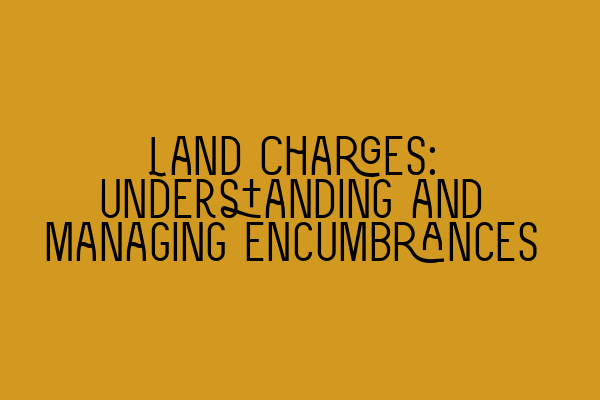Land Charges: Understanding and Managing Encumbrances
Introduction
When it comes to property transactions, understanding and managing encumbrances is crucial. The presence of encumbrances can significantly impact the value and marketability of a property, making it essential for property owners, buyers, and solicitors to have a comprehensive understanding of land charges. In this blog post, we will delve into the world of land charges, discuss the different types of encumbrances, and provide insights on how to effectively manage them. So, let’s dive in!
1. What are Land Charges?
Land charges are registered interests or rights that affect a property. They create legal encumbrances, limiting the property owner’s rights and potentially affecting its transferability or mortgagability. These charges are recorded in the Land Charges Register (LCR) and serve as a means of public notice for anyone interested in dealing with the property.
2. Types of Land Charges
a) Legal Charges: Legal charges are created when a property is used as security for a loan or mortgage. They give the lender a charge over the property, ensuring that if the borrower defaults on the loan, the lender has a legal right to sell the property to recover the debt. Legal charges are commonly encountered in property transactions and are crucial to assess when buying or selling a property.
b) Restrictive Covenants: Restrictive covenants are contractual obligations imposed on the owner of a property by a previous owner or a relevant party, such as a local authority or developers. These covenants restrict the use or development of the property and are registered as charges against the property. It’s important to understand and comply with restrictive covenants to avoid potential legal disputes.
c) Easements: Easements are rights that someone has over another person’s property, such as a right of way or a right to access utilities. Easements can be created by express grant, implied grant, or prescription. It’s crucial to identify and understand easements, as they can impact the property’s use and development rights.
d) Caution Against First Registration: When a property is not yet registered with the Land Registry, a caution can be lodged against first registration to protect someone’s interest in the property. This caution alerts any potential buyers or lenders that there may be a claim or right over the property that needs to be addressed.
e) Notice of Home Rights: In cases of divorce or separation, a non-owning spouse or civil partner can register a notice of home rights against the property to protect their occupancy rights. This notice provides them with a legal right to occupy the property, even if they are not the legal owner.
3. Managing Land Charges
a) Conducting a Land Charges Search: Before purchasing a property, it’s crucial to conduct a land charges search to identify any potential encumbrances. This search provides vital information about the current status of the property, including any registered land charges or restrictions. A thorough search will help you make an informed decision and assess any potential risks.
b) Reviewing Search Results: After obtaining the search results, it’s important to review them carefully. Pay close attention to any legal charges, restrictive covenants, easements, cautions against first registration, or notices of home rights. Seek legal advice if any issues or concerns arise from the search results.
c) Resolving Land Charges Issues: If you encounter any land charges that may impact your property transaction, it’s crucial to address them in a timely and appropriate manner. Consult with a property law solicitor who can guide you through the necessary steps to resolve any issues. For example, seeking a release or discharge of a legal charge, negotiating with relevant parties regarding restrictive covenants, or applying for an easement to be recognized or extinguished.
d) Updating Land Registry Records: Once land charges are resolved or satisfied, it’s important to update the Land Registry records accordingly. This ensures that future buyers or lenders have an accurate and up-to-date understanding of the property’s status and any encumbrances that may affect it.
Conclusion
In conclusion, understanding and managing land charges are crucial aspects of property law. Whether you are a property owner or in the process of buying or selling a property, having a comprehensive understanding of different types of land charges and how to effectively manage them is essential. Conducting thorough land charges searches, reviewing search results, and seeking legal advice when necessary can help you navigate the complexities of encumbrances and ensure a smooth and successful property transaction.
Related Articles:
– Parties in a Contract: Rights and Responsibilities
– Unveiling Duress and Undue Influence in Contracts
– Essentials of Consideration: Understanding the Backbone of Contracts
– Damages in Contract Law: Assessing Financial Compensation
– Express and Implied Terms in Contracts: Decoding Agreement Components
